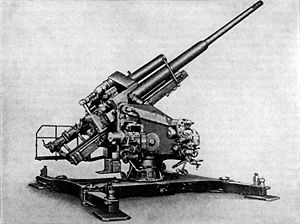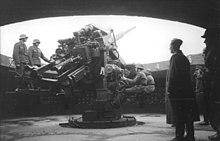| 12.8 cm Flak 40 | |
|---|---|
 A static mounted 12.8 cm Flak 40 | |
| Type | Anti-aircraft gun |
| Place of origin | Nazi Germany |
| Service history | |
| In service | 1942–45 |
| Used by | Nazi Germany |
| Wars | World War II |
| Production history | |
| Designer | Rheinmetall-Borsig |
| Designed | 1936 |
| Manufacturer | Rheinmetall-Borsig |
| Produced | 1942 |
| No. built | 1,125 |
| Variants | 12.8 cm FlaK 40 12.8 cm FlaK 40 Zwilling |
| Specifications | |
| Mass | 17,000 kg (37,478 lbs) |
| Length | 7.835 m (25 ft 8 in) |
| Barrel length | 7.8 m (25 ft 7 in) 61 calibers[1] |
| Shell | 128 x 958mm R[2] |
| Shell weight | 26 kg (57 lb 5 oz) |
| Caliber | 128 mm (5.03 in) |
| Breech | Horizontal sliding-block |
| Recoil | Hydro-pneumatic |
| Carriage | Static or railcar mounted. |
| Elevation | -3 to +88 degrees |
| Traverse | 360 degrees |
| Rate of fire | 10 to 12 rounds per minute |
| Muzzle velocity | 880 m/s (2,887 ft/s) |
| Maximum firing range | 14,800 m (48,556 ft) |
| Feed system | Power rammer |
The 12.8 cm FlaK 40 was a German anti-aircraft gun used in World War II. Although it was not produced in great numbers, it was reportedly one of the most effective heavy AA guns of its era.[3]

